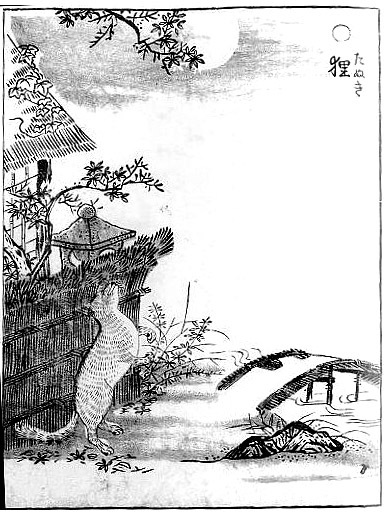
Of all the yokai, tanuki is definitely in the top three most popular yokai across the globe. Second, only to kitsune (狐) the supernatural fox of Japan. The popularity of tanuki significantly increased after Studio Ghibli‘s Pom Poko movie. The movie showed the prowess of the tanuki as shapeshifting yokai with massive balls.
In Japanese folklore, tanuki, kitsune and mujina (貉) are the most common yokai shape-shifting ability. In fact, tanuki is the master at shape-shifting and deception. They can transform into anyone and anything. In one story, a tanuki changed into a shamisen player and then, instantaneously transform into a horse’s ass. That is shape-shifiting skills at its best.

Edo-Period Depictions
In the first volume of Gazu Hyakki Yagyō, Toriyama Sekien illustrates tanuki as a typical racoon dog. The plain creature stands on two feet staring at the moon. By contrast, contemporary depictions show tanuki as a kawaii pot-bellied yokai. One that walks on two legs and pesters Japanese citizens.
Also, many Edo period illustrations show tanuki behaving as fishermen, farmers or merchants. They fish, smoke and even participate in a matsuri. They transform into faceless man to prank village folks. However, these pranks are nothing compared to tanuki‘s massive balls.

Gold Sacks
Interestingly, many Edo period artworks show tanuki with large scrotums. As illustrated, tanuki use their malleable scrotum as sails for boats and nets for fishing. Furthermore, tanuki are renown for using their nutsacks as parachutes. In contrast, the myths and legends hardly talk about the large scrotum. In fact, only modern stories embellish tanuki‘s prowess.
Moreover, testicles are known as kintama (金玉), literally golden balls in Japan. This links back to past metallurgists who use real tanuki scrotum to make gold leaves. In fact, workers hammer thin gold sheets between scrotum skins. In fact, tanuki skin can to stretch without breaking. Some say it can stretch 8 tatami wide (about 13 square meter).
Conclusion
Nonetheless, this is far from sufficient to show the tanuki influence. In the future, we will discuss many more yokai that fall under the tanuki category. At this point, appreciate the many wonders of this shapeshifting yokai. A creature found in many Japanese myths and legends. And lastly, a yokai with mystifyingly massive balls.
Yokai Details
- name: tanuki ( tah-nu-key )
- kanji: 狸 (たぬき)
- meaning: racoon dog
- aka: タヌキ, 化け狸
- abilities:
- shapeshifting — change its form to impersonate others
- voice manipulation — change their voice to fit their disguise
- inanimate morphing — transform itself or parts of itself into inanimate objects like drums,weapons and umbrellas
- scrotum enlargement — able to enlarge its testicles to various sizes





